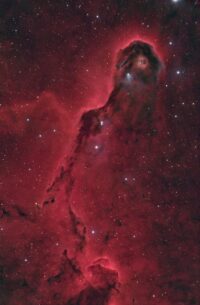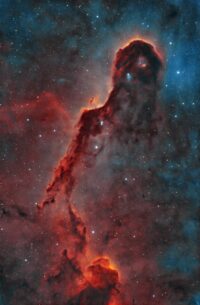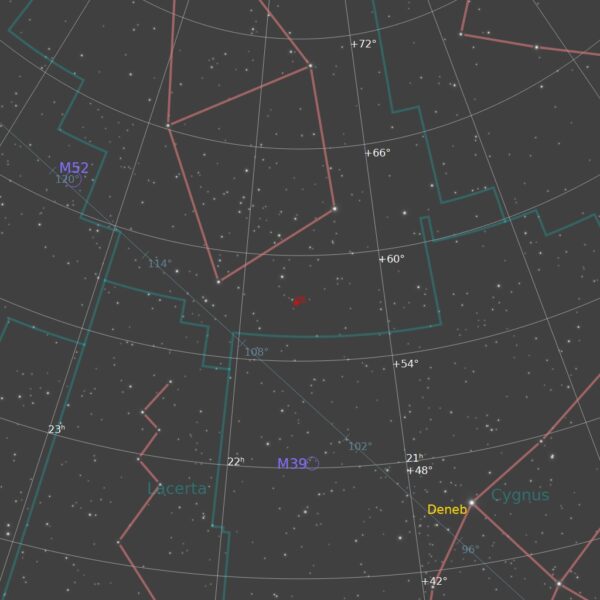vdB 142 in Three Palettes
Click an image for full size version
September 10, 2024
vdB 142 is often called the Elephant’s Trunk Nebula, and the round cavity at the top of this image is designated as IC 1396A. This object lies in Cepheus, and is part of a much larger emission nebula, IC 1396, that is about 100 light years across, and lies about 2,400 light years away. By comparison, the Elephant’s Trunk has a length of about 20 light years. This is a star forming region, and some of the stars in this image are very young – under 100,000 years old.
These emission nebula lend themselves to some really interesting colour palettes. The mostly red image is a natural colour imaged enhanced with light acquired through a narrowband H-alpha filter. The other two are false-colour images made with filters that pass emissions from hydrogen, oxygen and sulfur. All three images have the same stars contribution, taken from the RGB data set.
Tekkies:
Acquisition, focusing, and control of Paramount MX mount with N.I.N.A., TheSkyX and PHD2. Primalucelab low=profile 2″ Essato focuser and ARCO rotator. Equipment control with PrimaLuce Labs Eagle 4 Pro computer. All pre-processing and processing in PixInsight. Acquired from my SkyShed in Guelph. Average to above-average transparency and seeing. Data acquired undervariable moonlight between August 15 – 30, 2024.
Celestron 14″ EDGE HD telescope at f/11 (3,931 mm focal length) and QHY600M camera binned 2×2 with Optolong filters.
28x5m Red = 2hr20m
27x5m Green = 2hr15m
26x5m Blue = 2hr10m
139x5m Ha = 11hr35m
126x5m O3 =10hr30m
126x5m S2 = 10hr30m
Total: 39hr20m
Preprocessing: The WeightedBatchPreProcessing script was used to perform calibration, cosmetic correction, weighting, registration, local normalization, integration, drizzle integration and auto-cropping.
Colour master: A colour master was made from the Red, Green and Blue masters using ChannelCombination in RGB mode.
Gradient Removal: DynamicBackgroundExtraction was applied to the RGB and narrowband masters.
Colour Calibration: ColorCalibration was used to calibrate the RGB master.
Deconvolution: BlurXterminator was used on the RGB and narrowband masters with Automatic psf at default settings.
Linear Noise Reduction: NoiseXterminator was applied to the RGB and narrowband masters with settings Amount=0.9 and Detail=0.35
Star Removal: StarXterminator was used to remove the stars from each of the RGB and narrowband masters, with default settings. Only the RGB stars-only image was preserved.
Hubble Palette Image Creation: The S and O masters were balanced to H using LinearFit and combined using ChannelCombination in RGB mode.
Stretching: HistogramTransformation was applied to the RGB, SHO and narrowband masters to make pleasing images. Approximate background level after the stretches was 0.10 for RGB and SHO and 0.08 for the individual narrowband masters.
Nonlinear Processing
HaRGB Image Creation: An HaRGB image was made using the NBRGBCombination script.
Foraxx Palette Image Creation: The stretched S, H and O masters were combined with Paul Hancock’s Foraxx Palette Utility script.
Background Cleanup: Artifacts that were visible in the three master images due to the extreme stretching were removed using the CloneStamp tool
Nonlinear Noise Reduction: NoiseXterminator was used to reduce noise in the background areas of the HaRGB, SHO and Forrax images with settings Amount=0.9 and Detail=0.15
Contrast Enhancement: LocalHistogramEqualization was applied twice to each image using a mask to protect the background. A Contrast Limit of 1.5 and 1 iteration was used for each LHE application (scale 40, strength 0.35; scale 150, strength 0.18).
Brightness Enhancement: Using a mask to protect the background and bright parts of the nebula, the faint parts of the nebula were brightened in each master image with ExponentialTransformation and CurvesTransformation.
Sharpening: A mask was used to select brighter regions of nebulosity in each image for sharpening with MultiscaleMedianTransform (Layers 1 – 4 with strengths of 0.01, 0.07, 0.07, and 0.03, respectively).
Hubble Palette and Foraxx Colour Adjustments: CurvesTransformation was used with the Hue tool to adjust the colour tones in the two narrowband images. The SelectiveColorCorrection script was used to make fine adjustmets to both narrowband masters.
Star Processing and Restoration: HistogramTransformation was used to stretch the stars-only RGB image, followed by CurvesTransformation through a star mask to boost saturation using the Saturation slider. The stars were added back into the HaRGB, SHO and Foraxx master images using the Screen blending mode in PixelMath using the expression combine(starless, stars, op_screen()).
Final Steps: Background, nebula and star brightness, contrast and saturation were adjusted using several iterations of CurvesTransformation, with masks, as required. ICCProfileTransformation (sRGB IEC61966-2.1; Relative Colorimetric with black point compensation) was applied prior to saving as a jpg. The finder chart was made using the FindingChart process.










Leave A Comment